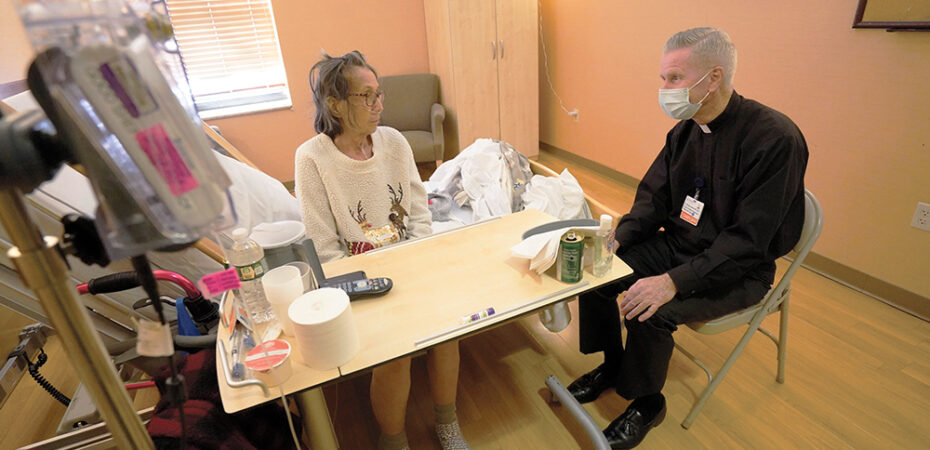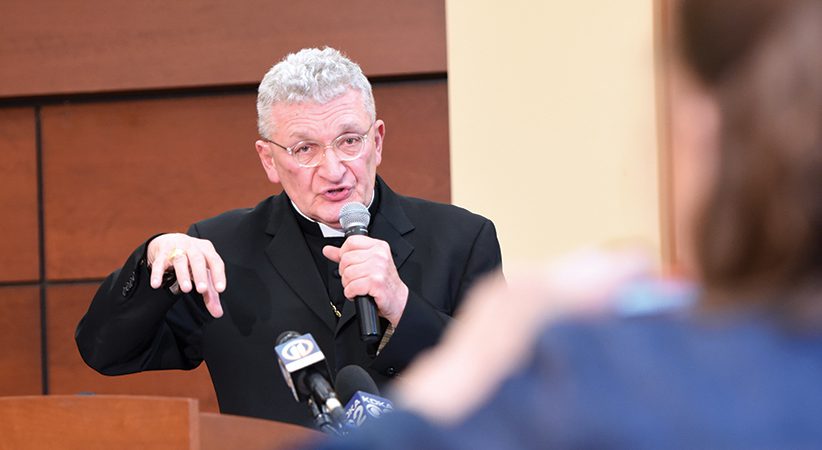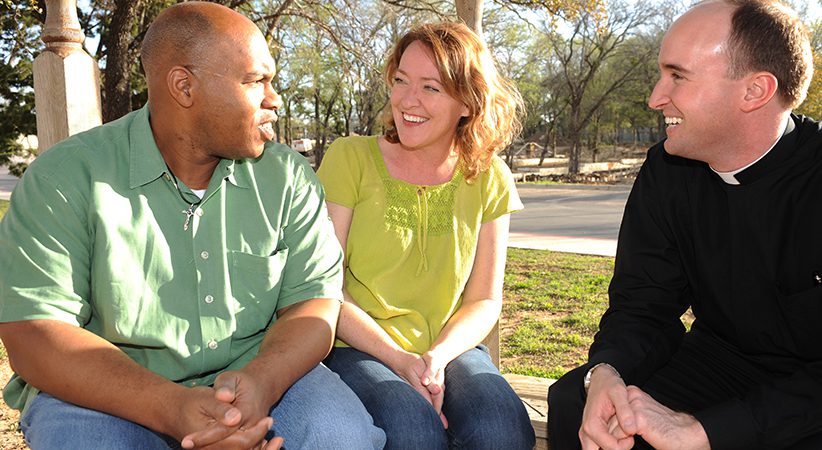Hospice Chaplain
Called to compassionate care
Father Richard S. Jones Comments Off on Hospice Chaplain
The old Latin aphorism Nemo dat, quad non hat (“You cannot give what you do not have”) I find particularly true when providing spiritual care as a hospital chaplain at UPMC Mercy in Pittsburgh, founded by the Sisters of Mercy in 1847. In order to help others who are suffering physically, emotionally, mentally, socially and spiritually, one must be humbled, balanced, integrated and spiritually developed.
Two of my brothers are physicians and one of my sisters serves as assistant dean of a medical school. One-third of my 35 years as a priest has been serving as a hospital chaplain. So, compassionate presence, empathetic service, and “wounded healers” ministry are part and parcel of our family DNA.
Pope Francis, in his book “Embrace of Hope — Compassion in Times of Illness” (U.S. Conference of Catholic Bishops, $12.95), writes: “Occasionally our world forgets the special value of time spent at the bedside of the sick, since we are in such a rush, caught up in a frenzy of doing, of producing, we forget about giving ourselves freely, taking care of others, being responsible for others. Behind this attitude, there is a lukewarm faith that has forgotten the Lord’s words: ‘You did it unto me.’ (Mt 25:40).” Time spent with the sick is true, holy time. For Jesus is the physician who heals with the medicine of love, and he takes upon himself our suffering and redeems it.
In the work “Hope for Caregivers” (IVP, $16), Father Henri J.M. Nouwen, edited by Susan Martins Miller, reflects on the word compassion, derived from the Latin words pati and cum, which together means “to suffer with.” Nouwen writes: “Compassion asks us to go where it hurts, to enter places of pain, to share in brokenness, fear, confusion, and anguish. Compassion challenges us to cry out with those in misery, to mourn with those who are lonely, to weep with those in tears. Compassion requires us to be weak with the weak, vulnerable with the vulnerable, and powerless with the powerless. Compassion means full immersion in the condition of being human.”
Practice of Hospitality
Each person has a story to tell, a song to sing, a message to deliver, and a life to touch others. The term “hospice” comes from the Latin word hospes, meaning both. We get the word “hospitality” from this root word, and it refers to a place of shelter and rest — thus symbolizing the mutual caring of people for one another. The apostle Peter exhorts us to “practice hospitality.” He writes: “Practice hospitality to one another (those of the household of faith). [Be hospitable, be a lover of strangers, with brotherly affection for the unknown guests, the foreigners, the poor, and all others who come your way who are Christ’s body.] And [in each instance] do it ungrudgingly (cordially and graciously, without complaining, but as representing Him)” (1 Pt 4:9, Amplified Bible, Classic Edition).
The favorite and familiar parable of the good Samaritan in the Gospel of Luke embodies the hospice philosophy of love thy neighbor and to care for those in need, as well as an exhortation by the Lord to “Go and do likewise” (cf. Lk 10:25-37). This memorable story no doubt inspired believers to be their brother’s keepers, to provide care for the annual travelers who converged on Jerusalem every year for the Passover and other religious celebrations, as well as those journeying to other locations.
…………………………………………………………………………………………………………………………………………..
A Prayer in Dark Times
Do you know the De Profundis prayer? Psalm 130 is a prayer for help:
“Out of the depths I call to you, LORD; / Lord, hear my cry! / May your ears be attentive / to my cry for mercy” (vv. 1-2).
It is a prayer we should offer at the darkest of times of life, when we find ourselves lost in the shadow of death, when in our desperations we feel utterly incapable of helping ourselves.
……………………………………………………………………………………………………………………………………………
In more recent times, Florence Nightingale (1820-1910), who gave up her Victorian wealth to care for the dying, and Elizabeth Fry (1780-1845), an English Quaker with the Sisters of Charity, were champions for the suffering. The Sisters of Charity developed a shelter in Dublin, Ireland, in 1910 for “the incurably ill” and called it, in English, “a hospice.” Until the 1900s, family members cared for their loved ones, even those critically injured or ill at home. Doctors made house calls and helped families prepare for the last moments.
Our modern-day concept of hospice care was pioneered by Dame Cicely Saunders who opened St. Christopher’s Hospice in London in 1967. She introduced the concept of palliative care, which focuses on the comfort of the patient through pain management rather than treatment for a cure. She developed the technique of pain control and total care for dying patients, which has become the cornerstone of hospices worldwide. Hospice is based on the belief that death is a natural part of the cycle of life. Hospice offers palliative care to all terminally ill and their families without regard of diagnosis, gender, sexual orientation, race, creed, disability, age, place of residence or ability to pay.
Increased Needs
In 1969, Dr. Elisabeth Kübler-Ross (1926-2004), a Swiss American psychiatrist, wrote the book “On Death and Dying” describing five ways to cope with approaching death. The five stages are denial, anger, bargaining, depression and acceptance. These stages also apply to bereaved family members going through the process of grief. Kübler-Ross helped start the hospice movement in the United States and was instrumental in getting Congress to pass the Medicare Hospice Benefit, which made hospice care available through Medicare benefits.
The need for hospice care greatly increased in the United States in the mid-1980s with the AIDS epidemic. Hospice care is a vital part of our society and culture. The entire philosophy of hospice ministry is to develop a caring team of people who offer patient-centered care. I feel humbled and honored to accompany patients and their families with a team that truly cares for patients’ end-of-life journeys. Some patients have months, weeks, days, and sometimes only hours and minutes to live. Hospice care is palliative, rather than curative. Hospice neither hastens nor postpones death but accepts death as the last phase of life. Hospice offers comprehensive care to highly skilled and trained professionals — physicians, nurses, social workers, chaplains, therapists, pharmacists, etc. — to work together to ensure they meet the needs of patients, families and caregivers as completely as possible. Hospice relies also on trained, compassionate volunteers to provide an extra set of hands and ears, both for patients and families.
I recall ministering to a brother priest (my age) of our diocese who was diagnosed with pancreatic cancer and despite having taken bouts of chemotherapy and radiation cancer, it continued to spread into other organs. Medically, there was nothing more that could be done. Yet, he trustingly surrendered and put all in the Lord’s hands and was at peace.
The new trend today in healthcare is patient-centered care — providing care to the person with respect, dignity and compassion. The patients themselves are a critical part of the decision-making process in how we care for them. The patient’s wants and needs must be paramount.
Holistic Approach
As a hospital chaplain, I take a holistic approach to ministering not only to the physical dimension but look at the mind, emotions, heart, soul and spirit. “Death is an inescapable part of life. We can’t prevent it; nor can we prevent the inevitable pain of separation it causes. However, we can make the experience of death better, both for the living and the dying,” writes David Kessler in “The Needs of the Dying” (Harper Perennial, $15.99).
I am always inspired by how many doctors, nurses, family members and visitors stop in our Holy Family Chapel in the hospital to be still, to pray and listen to Jesus the Healer. I know for certain that I could not walk this path daily without the infusion of spiritual strength and divine direction for each new day. One cannot underestimate the value of “ministry of presence” and “smile therapy,” which can help us be light, calm, comforting, a companion and a listener. Simple presence speaks volumes of comfort to those in need. One must walk in humility and thankfulness that we are a small part of a wonderful mission of healing, hope and miracles of love.
Being an on-call hospital chaplain means one must be ready for active duty when the time comes — to be there for others in their time of need. It is a sacred place to be. Dame Cicely Saunders of St. Christopher’s Hospice in London reminds chaplains who are part of the hospice team that we are “not there to take away or explain, or even understand, but simply ‘watch’ with our patients.” Each of us must enjoy the sacred journey that God has placed us in — namely, to love and care for one another all our days.
FATHER RICHARD S. JONES was ordained a priest for the Diocese of Pittsburgh in 1988. He is the chaplain of UPMC Mercy Hospital in Pittsburgh.





